Plant Select®, a collaborative effort with Denver Botanic Gardens, Colorado State University and horticultural professionals, is pleased to announce eight new plants to be promoted for 2013. These plants are especially valuable to regional gardeners and landscape professionals in light of outdoor water restrictions currently being imposed in many communities region-wide. Water needs are highlighted below in italics (xeric= no additional irrigation needed once established; dry= little additional irrigation needed once established).
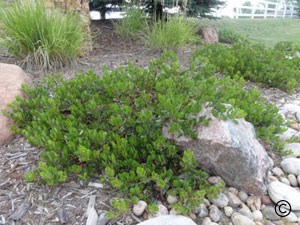 Chieftain manzanita (Arctostaphylos x coloradensis ‘Chieftain’) is a Colorado Uncompaghre Plateau selection that is a much more vigorous manzanita than other Plant Select® introductions. Oval leaves emerge with a reddish tint changing to bold dark green, persisting through the winter making this an outstanding evergreen groundcover. White flowers tinged with pink appear in late spring followed by red berries in early fall. Striking, smooth cinnamon-red to purplish exfoliating bark appears as the plant matures. Grows 18-36 inches tall and 5-8 feet wide in full to part shade. Prefers well-drained soils and is tolerant of xeric conditions once established. Hardy to USDA zones 5-8.
Chieftain manzanita (Arctostaphylos x coloradensis ‘Chieftain’) is a Colorado Uncompaghre Plateau selection that is a much more vigorous manzanita than other Plant Select® introductions. Oval leaves emerge with a reddish tint changing to bold dark green, persisting through the winter making this an outstanding evergreen groundcover. White flowers tinged with pink appear in late spring followed by red berries in early fall. Striking, smooth cinnamon-red to purplish exfoliating bark appears as the plant matures. Grows 18-36 inches tall and 5-8 feet wide in full to part shade. Prefers well-drained soils and is tolerant of xeric conditions once established. Hardy to USDA zones 5-8.
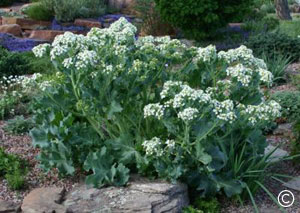
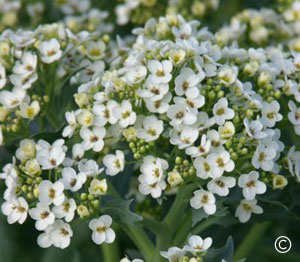 Curly leaf sea kale (Crambe maritima) is a robust, traditional European perennial potherb forming impressive 24 inch tall by 24-30 inches wide clumps of gorgeous, wavy, waxy blue foliage all summer long. In spring, clusters of dazzling white flowers grace the garden. Tough and permanent once established, this beautiful perennial offers larger-scale, summer-long interest for dry gardens. Prefers full sun and tolerates a wide range of moderate to dry soil conditions. Hardy to USDA zones 4-8.
Curly leaf sea kale (Crambe maritima) is a robust, traditional European perennial potherb forming impressive 24 inch tall by 24-30 inches wide clumps of gorgeous, wavy, waxy blue foliage all summer long. In spring, clusters of dazzling white flowers grace the garden. Tough and permanent once established, this beautiful perennial offers larger-scale, summer-long interest for dry gardens. Prefers full sun and tolerates a wide range of moderate to dry soil conditions. Hardy to USDA zones 4-8.
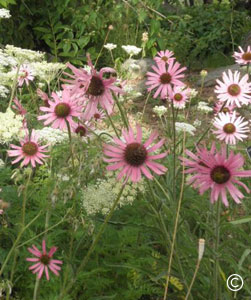 We’re promoting Tennessee purple coneflower (Echinacea tennesseensis) in 2013 to celebrate its delisting from the Federal Endangered Species list. This American purple coneflower is a refreshing addition to summer borders with amazing adaptability. Once endangered in the wild, conservation efforts have brought native populations back to healthy levels. Beautiful purple-pink flowers bloom cheerily during summer, always facing east so be sure to site properly. Blooms June to August in moderate to dry sites in full sun to part shade. Grows 18-24 inches tall and 15-18 inches wide. Hardy to USDA zones 5-6.
We’re promoting Tennessee purple coneflower (Echinacea tennesseensis) in 2013 to celebrate its delisting from the Federal Endangered Species list. This American purple coneflower is a refreshing addition to summer borders with amazing adaptability. Once endangered in the wild, conservation efforts have brought native populations back to healthy levels. Beautiful purple-pink flowers bloom cheerily during summer, always facing east so be sure to site properly. Blooms June to August in moderate to dry sites in full sun to part shade. Grows 18-24 inches tall and 15-18 inches wide. Hardy to USDA zones 5-6.
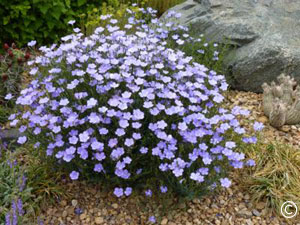 Narbonne blue flax (Linum narbonense) is a Mediterranean form of blue flax that is much more long-lived and fuller than the western native species. Blooming for months on end, the deep sky blue flowers are larger and more flaring. This robust plant grows 15-18 inches tall and 15-18 inches wide offering a dense mound of attractive, nearly evergreen foliage for garden borders, wildflower gardens and informal plantings. Thrives in well-drained soils in full sun to part shade and tolerates xeric conditions once established. Hardy to USDA zones 5-8.
Narbonne blue flax (Linum narbonense) is a Mediterranean form of blue flax that is much more long-lived and fuller than the western native species. Blooming for months on end, the deep sky blue flowers are larger and more flaring. This robust plant grows 15-18 inches tall and 15-18 inches wide offering a dense mound of attractive, nearly evergreen foliage for garden borders, wildflower gardens and informal plantings. Thrives in well-drained soils in full sun to part shade and tolerates xeric conditions once established. Hardy to USDA zones 5-8.
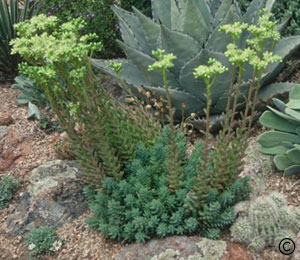
 Turquoise Tails blue sedum (Sedum sediforme) is a robust yet compact, turquoise-blue selected form of the Mediterranean species. Creamy-yellow flowers rise above succulent blue mounds in mid-summer, creating a sculptural accent for xeric gardens. Growing 4-6 inches tall and 6-12 inches wide it survives with very low care in northern Colorado, and is virtually deer-resistant. Pioneered regionally by Lauren & Scott Ogden and Kelly Grummons. Hardy to USDA zones 5-10.
Turquoise Tails blue sedum (Sedum sediforme) is a robust yet compact, turquoise-blue selected form of the Mediterranean species. Creamy-yellow flowers rise above succulent blue mounds in mid-summer, creating a sculptural accent for xeric gardens. Growing 4-6 inches tall and 6-12 inches wide it survives with very low care in northern Colorado, and is virtually deer-resistant. Pioneered regionally by Lauren & Scott Ogden and Kelly Grummons. Hardy to USDA zones 5-10.
NEW PROGRAM: PLANT SELECT® PETITES!
The Plant Select® Petites program debuts noteworthy, well-adapted, unusual plants of smaller stature that have not yet been readily available or known to gardeners. The program also promotes innovative ways to plant and enjoy these treasures in garden situations where small gem-like but tough plants are best suited: troughs, permanent containers, rock gardens, patio gardens, fairy gardens, green roofs, and smaller gardens. Three plants are being promoted for 2013.
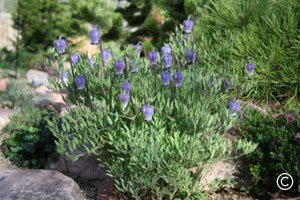
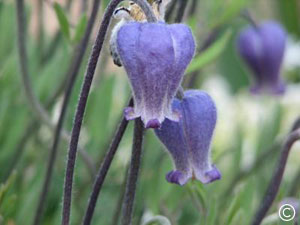 Western native, long-blooming Scott’s sugarbowls, Scott’s clematis (Clematis scottii) makes a mound of blue-green, lacy foliage, topped in late spring and early summer by large, nodding blue flowers. Bees and bumblebees frequent the bell-shaped blossoms. Shimmering golden seed heads follow suit. Grows 8-15 inches tall and 12-15 inches wide, blooming May to July. Requires full sun and tolerates most moderate to dry soils. Hardy to USDA zones 4-7.
Western native, long-blooming Scott’s sugarbowls, Scott’s clematis (Clematis scottii) makes a mound of blue-green, lacy foliage, topped in late spring and early summer by large, nodding blue flowers. Bees and bumblebees frequent the bell-shaped blossoms. Shimmering golden seed heads follow suit. Grows 8-15 inches tall and 12-15 inches wide, blooming May to July. Requires full sun and tolerates most moderate to dry soils. Hardy to USDA zones 4-7.
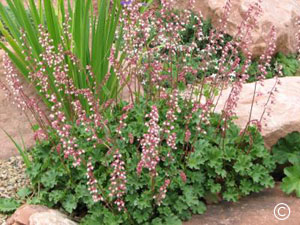
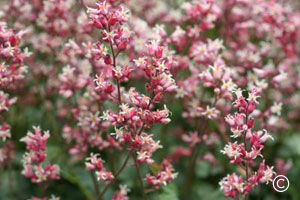 Sandia coralbells (Heuchera pulchella) is a miniature, extra cute version of the well-known coralbells with a tidy evergreen tussock of ruffled fresh green leaves. Spikes of petite rose-pink bells emerge in late spring, attracting hummingbirds and bees. Native to high elevation sites in New Mexico, it thrives in well-drained soils in full sun to shade with moderate to low water. Foliage stays low (~3 inches tall by 6-10 inches wide) while flower spikes grow up to 8 inches tall. Hardy to USDA zones 4-7.
Sandia coralbells (Heuchera pulchella) is a miniature, extra cute version of the well-known coralbells with a tidy evergreen tussock of ruffled fresh green leaves. Spikes of petite rose-pink bells emerge in late spring, attracting hummingbirds and bees. Native to high elevation sites in New Mexico, it thrives in well-drained soils in full sun to shade with moderate to low water. Foliage stays low (~3 inches tall by 6-10 inches wide) while flower spikes grow up to 8 inches tall. Hardy to USDA zones 4-7.
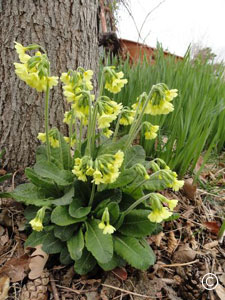
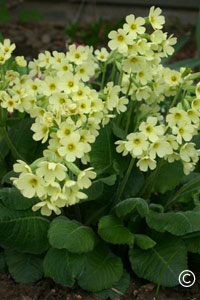 Oxslip primrose (Primula elatior) is a charming but tough primrose that is more persistent and tolerates more heat and drought than most of its kin. Clusters of soft yellow flowers, often fragrant, rise above pale green rosettes of foliage in spring. Plants grow 10-15 inches tall by 12-15 inches wide in moderate to dry soils in partial shade. This is the true wild form rarely found in the trade. Hardy to USDA zones 4-8.
Oxslip primrose (Primula elatior) is a charming but tough primrose that is more persistent and tolerates more heat and drought than most of its kin. Clusters of soft yellow flowers, often fragrant, rise above pale green rosettes of foliage in spring. Plants grow 10-15 inches tall by 12-15 inches wide in moderate to dry soils in partial shade. This is the true wild form rarely found in the trade. Hardy to USDA zones 4-8.
The mission of Plant Select® is to seek out and distribute the best plants for landscapes from the High Plains to the Intermountain region and beyond. To be included in the program, selected plants should:
- Thrive in a broad range of garden situations in the Rocky Mountain region
- be resilient to the region’s challenging climate
- Exemplify the unique
- Demonstrate disease and insect resistance
- Flourish in low water conditions
- Display a long season of beauty in the garden
- Ensure noninvasiveness
For all the Plant Selecté recommendations, see plantselect.org.



